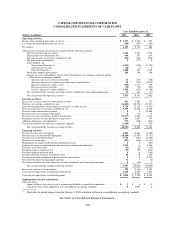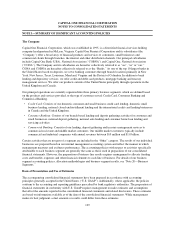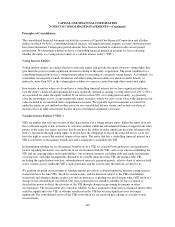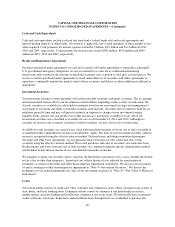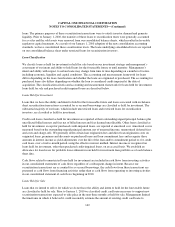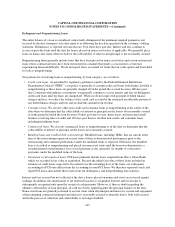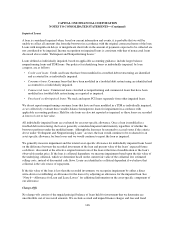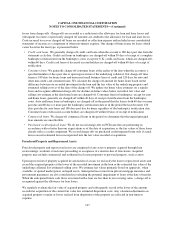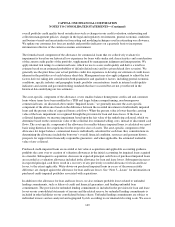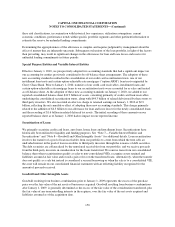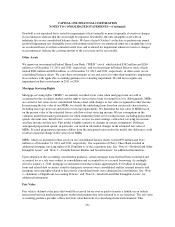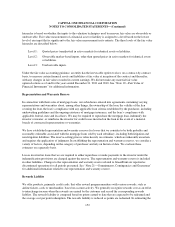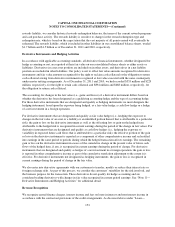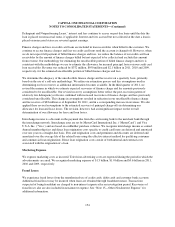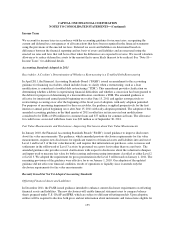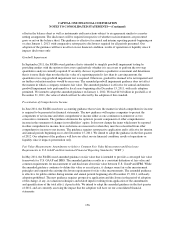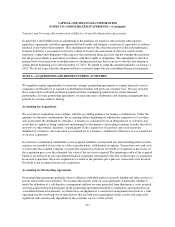Capital One 2011 Annual Report Download - page 167
Download and view the complete annual report
Please find page 167 of the 2011 Capital One annual report below. You can navigate through the pages in the report by either clicking on the pages listed below, or by using the keyword search tool below to find specific information within the annual report.CAPITAL ONE FINANCIAL CORPORATION
NOTES TO CONSOLIDATED STATEMENTS—(Continued)
losses from charge-offs. Charge-offs are recorded as a reduction to the allowance for loan and lease losses and
subsequent recoveries of previously charged off amounts are credited to the allowance for loan and lease losses.
Costs incurred to recover charged-off loans are recorded as collection expense and included in our consolidated
statements of income as a component of other non-interest expense. Our charge-off time frame for loans, which
varies based on the loan type, is presented below.
•Credit card loans: We generally charge-off credit card loans when the account is 180 days past due from the
statement cycle date. Credit card loans in bankruptcy are charged-off within 30 days of receipt of a complete
bankruptcy notification from the bankruptcy court, except for U.K. credit card loans, which are charged-offs
within 60 days. Credit card loans of deceased account holders are charged-off within 60 days of receipt of
notification.
•Consumer loans: We generally charge-off consumer loans at the earlier of the date when the account is a
specified number of days past due or upon repossession of the underlying collateral. Our charge-off time
frame is 180 days for home loans and unsecured small business lines of credit and 120 days for auto and
other non-credit card consumer loans. We calculate the charge-off amount for home loans based on the
difference between our recorded investment in the loan and the fair value of the underlying property and
estimated selling costs as of the date of the charge-off. We update our home value estimates on a regular
basis and recognize additional charge-offs for declines in home values below our initial fair value and
selling cost estimate at the date home loans are charged-off. Consumer loans in bankruptcy, except for auto
and home loans, generally are charged-off within 40 days of receipt of notification from the bankruptcy
court. Auto and home loans in bankruptcy are charged-off in the period that the loan is both 60 days or more
past due and 60 days or more past the bankruptcy notification date or in the period the loan becomes 120
days past due for auto loans and 180 days past due for home regardless of the bankruptcy notification date.
Consumer loans of deceased account holders are charged-off within 60 days of receipt of notification.
•Commercial loans: We charge-off commercial loans in the period we determine that the unpaid principal
loan amounts are uncollectible.
•Purchased credit-impaired loans: We do not record charge-offs on PCI loans that are performing in
accordance with or better than our expectations as of the date of acquisition, as the fair values of these loans
already reflect a credit component. We record charge-offs on purchased credit-impaired loans only if actual
losses exceed estimated losses incorporated into the fair value recorded at acquisition.
Foreclosed Property and Repossessed Assets
Foreclosed property and repossessed assets are comprised of any asset or property acquired through loan
restructurings, workouts, foreclosure proceeding or acceptance of a deed-in-lieu of foreclosure. Acquired
property may include commercial and residential real estate properties or personal property, such as autos.
Upon repossession of property acquired in satisfaction of a loan, we reclassify the loan to repossessed assets and
record the acquired property at the lower of the recorded investment in the loan or the estimated fair value of the
underlying collateral less estimated selling costs. We estimate fair values primarily based on appraisals, when
available, or quoted market prices on liquid assets. Anticipated recoveries from private mortgage insurance and
government guarantees are also considered in evaluating the potential impairment of loans at the date of transfer.
When the anticipated future cash flows associated with a loan are less than its net carrying value, a charge-off is
recognized against the allowance for loan losses.
We regularly evaluate the fair value of acquired property and subsequently record at the lower of the amount
recorded at acquisition or the current fair value less estimated disposition costs. Any valuation adjustments on
acquired property or gains or losses realized from disposition of the property are reflected in non-interest
expense.
147



